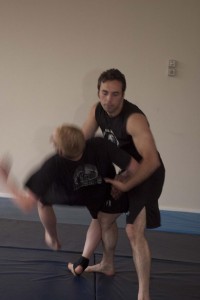
07.10.17
This morning saw the final part of my client’s first course in basic stand-up grappling for martial arts cross training. The 10 hour course focused mainly on takedowns and takedown defence. The final part of the course brought the training back round to self-defence tactics, looking at how the clinch range works within the context of counter-assault situations. For the most part, I am with the argument that grappling works best as a backup system in a defence against an assault. The reason for this is because striking is geared towards creating distance and is the best tool for disengagement. Grappling, by its definition, is largely concerned with engagement. Time is a huge issue when it comes to self-protection, as it is  whenever you are dealing with something that is high risk. This is something all responsible fire marshals and first-aiders will tell you. The same applies in an assault. The longer you spend handling an aggressor that is more than likely to have several physical advantages of you – such as size, weapons, greater number of people on his side – the greater the risk level to everyone. Therefore, when we are looking at high-level risk situations, we are seeking tools that will deal with a situation as quickly as possible and best facilitate escape. Nevertheless, when you are in grappling range ignorance of some form of wrestling can cost you dearly. A person with greater striking skills than you can also be problematic if you don’t have any extra supporting tools. Furthermore, grappling is the perfect range for handling the more likely situation of a mid-level threat when control and restraint are more the order of the day than attempting to knock someone out.
whenever you are dealing with something that is high risk. This is something all responsible fire marshals and first-aiders will tell you. The same applies in an assault. The longer you spend handling an aggressor that is more than likely to have several physical advantages of you – such as size, weapons, greater number of people on his side – the greater the risk level to everyone. Therefore, when we are looking at high-level risk situations, we are seeking tools that will deal with a situation as quickly as possible and best facilitate escape. Nevertheless, when you are in grappling range ignorance of some form of wrestling can cost you dearly. A person with greater striking skills than you can also be problematic if you don’t have any extra supporting tools. Furthermore, grappling is the perfect range for handling the more likely situation of a mid-level threat when control and restraint are more the order of the day than attempting to knock someone out.
Training began with a revision of all throwing entries taught over the course. Using necktie, wrist-grab, arm-drag and over-hook/under-hook set-ups we fluidly moved through two-on-ones, waist-locks, major outer-reap throws, major hip throws, single-arm shoulder throws, supplexes, single and double-leg takedowns.

We then went back to a strong starting point for all self-defence: the fence. This set-up is usually for pre-emptive striking, but it can also be used for going to the clinch range and restraining someone. We used it to take the back and into a harness-hold, waist-lock, full-nelson and choke. The position, if done correctly, provides the user with protection from backward head-butts, foot-stamps and backward elb ow strikes. We tested standing back-holds against a typical defence, using a wall as a weapon. The back-holds, if done correctly, provide the user with a huge benefit of spreading out and dispersing a lot of any impact outside of sharp edges. There is a common mistaken belief, reinforced by a lot of fictional media, that such an impactful defence is a sure-fire way to remove a back-hold.
ow strikes. We tested standing back-holds against a typical defence, using a wall as a weapon. The back-holds, if done correctly, provide the user with a huge benefit of spreading out and dispersing a lot of any impact outside of sharp edges. There is a common mistaken belief, reinforced by a lot of fictional media, that such an impactful defence is a sure-fire way to remove a back-hold.
Next we went back over eye-gouges and close-range striking within clinch range before moving onto the philtrum takedown, which is now improved with my client’s knowledge of the major outer-reap throw. This technique is accessed from close-range stand-up grappling and can also be substituted with a throat grab or palm to the chin.
Finally, we looked at accessing high, mid and low attack lines for takedowns against a dominant striker. Here we used the cover to access the different lines.
Accessing the three attack lines using the cover at a seminar I gave in Denmark, 2013:
Above photographs by Charlotte Von Bulow Quirk Photography 2013 except the last one by Sonia Audhali Photography 2009.
